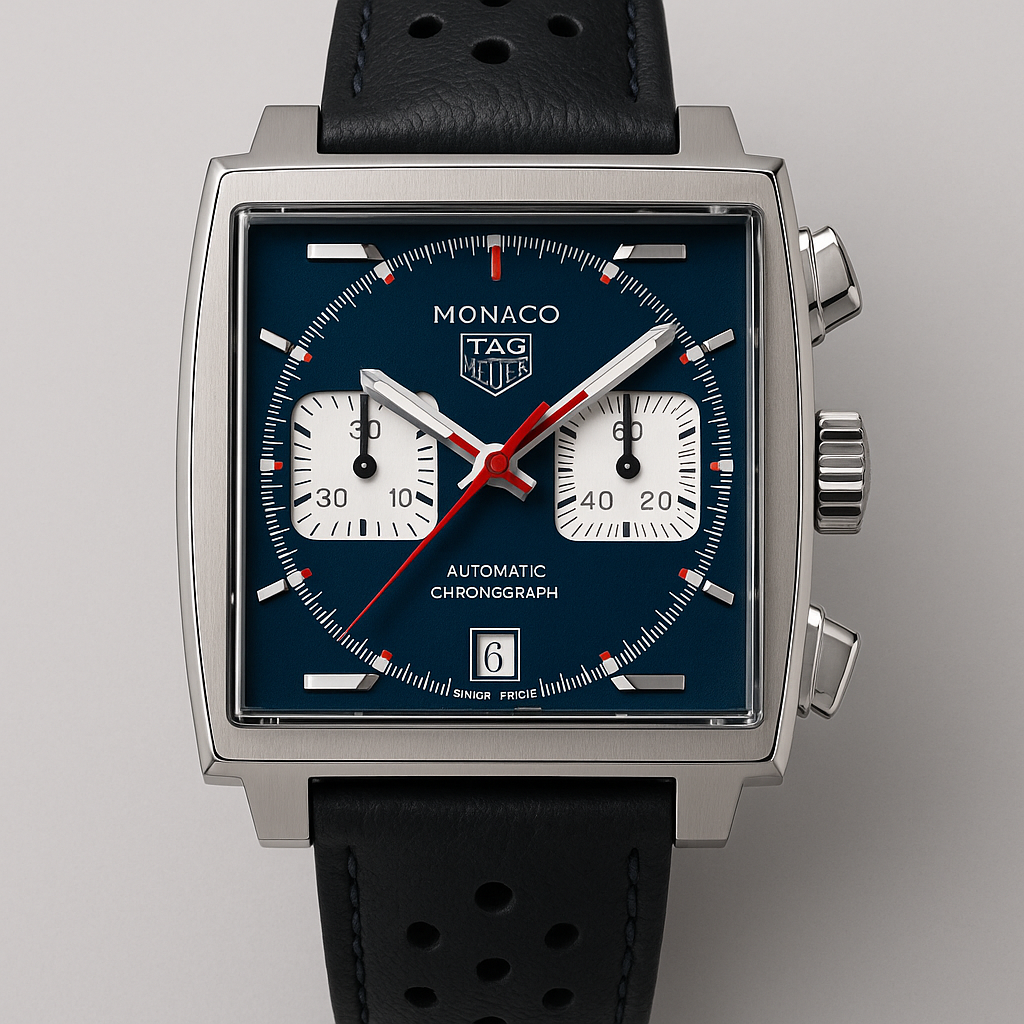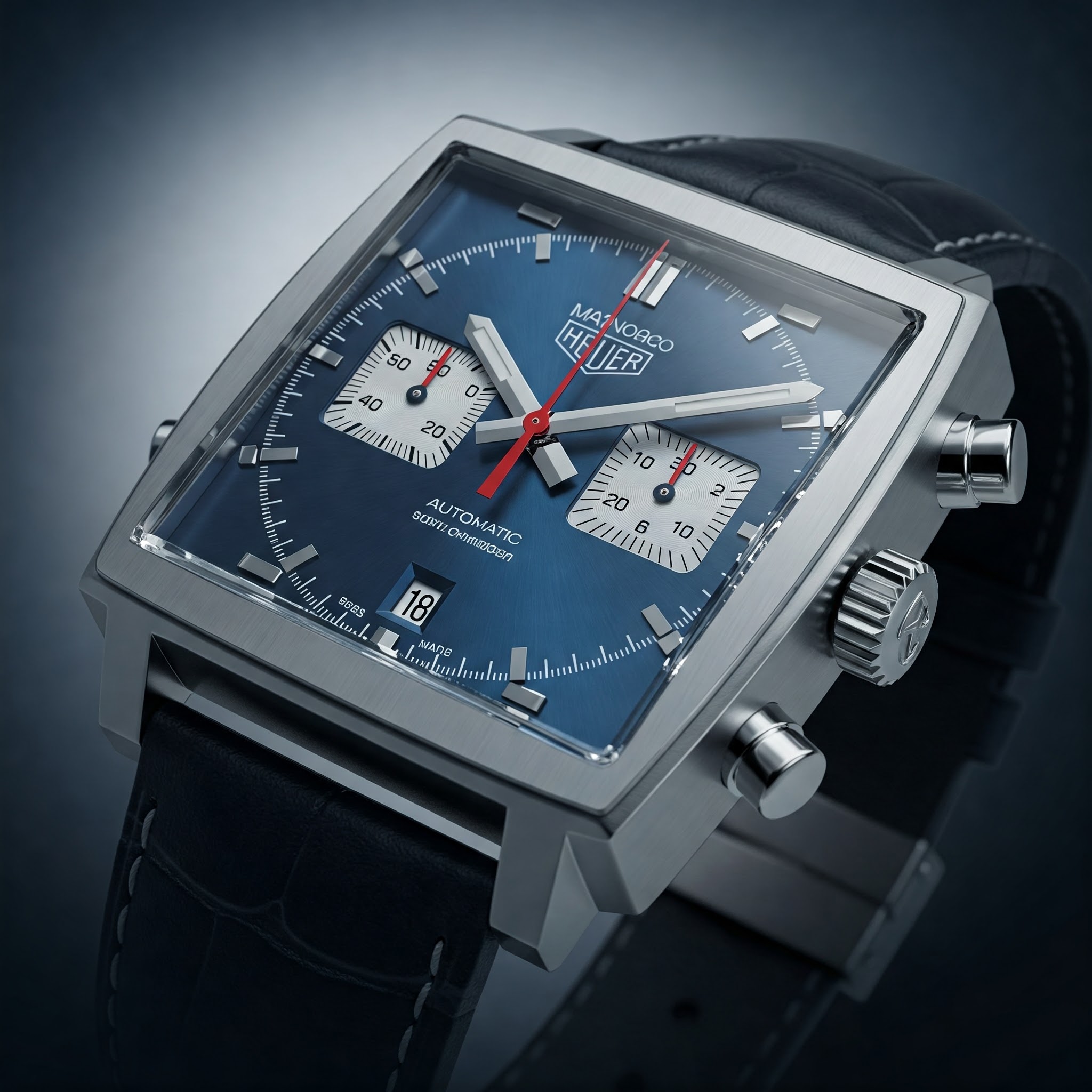In the pantheon of horological legends, few watches possess the immediate recognition and rebellious magnetism of the TAG Heuer Monaco. Its bold, square-cased defiance of convention is a story in itself, but when fused with the aura of Hollywood’s ultimate “King of Cool,” Steve McQueen, it transcended mere timekeeping to become a potent symbol of maverick style and motorsport grit. The 1971 film Le Mans was the crucible where this legend was forged, catapulting a technically innovative timepiece from a daring design experiment into an enduring cultural icon. This is the story of how the TAG Heuer Monaco, strapped to McQueen’s wrist, raced from the silver screen into the hearts of collectors and style aficionados worldwide.
Breaking the Mold: The Genesis of the Heuer Monaco
The late 1960s were a period of seismic shifts in design, culture, and technology, and the watch industry was no exception. Traditional round watch cases were the undisputed norm. Into this landscape stepped Jack Heuer, a man with a visionary ambition to shatter horological conventions. He envisioned a watch that was audacious, instantly recognizable, and technically superior: the Heuer Monaco.
The Monaco’s most striking feature was, and remains, its square case. This was not just an aesthetic choice but a significant technical hurdle. Creating a truly water-resistant square case was a challenge that many deemed impossible. Heuer collaborated with Swiss case manufacturer Erwin Piquerez, who had recently patented a novel square case design featuring a system of four notches clipping into the back, creating a perfectly sealed housing. This innovation allowed Jack Heuer to realize his vision. Launched in 1969, the Monaco, named after the glamorous Formula One Grand Prix, was not just a watch; it was a statement. Its vibrant metallic blue dial, contrasting white sub-dials, and bold red accents were as unconventional as its shape, perfectly capturing the avant-garde spirit of the era.
The Heart of a Champion: The Calibre 11 Innovation
Beyond its disruptive design, the original Heuer Monaco (reference 1133B) housed a groundbreaking movement: the Calibre 11. This was one of the world’s first automatic chronograph movements, a monumental achievement in watchmaking. Developed in secret by a consortium known as Project 99 – comprising Heuer-Leonidas, Breitling, Hamilton-Buren, and chronograph specialist Dubois-Depraz – the “Chronomatic” Calibre 11 was a marvel of micro-engineering.

One distinctive feature of watches powered by the early Calibre 11 (and its successor, the Calibre 12) was the placement of the crown on the left side of the case, with the chronograph pushers remaining on the right. This unconventional arrangement served as a visual cue: being an automatic movement, it didn’t require daily manual winding, thus the crown was less frequently used. This technical prowess added another layer to the Monaco’s allure, marking it as a pioneer in both form and function. It was a serious tool watch, designed for the demanding world of motorsport.
The Celluloid Catapult: Steve McQueen and Le Mans
While the Monaco was undeniably innovative, its ascent to cult status was irrevocably ignited by Steve McQueen. Known for his meticulous attention to detail and his pursuit of authenticity in his roles, McQueen was deeply involved in the production of the 1971 film Le Mans. He aimed to create the most realistic depiction of endurance racing ever committed to celluloid. For his character, Michael Delaney, a stoic and supremely skilled Porsche 917 driver, every detail had to be perfect, including his watch.
The story of how the Monaco landed on McQueen’s wrist is part of its legend. Don Nunley, the film’s property master, offered McQueen a selection of watches. McQueen, having sought advice from his friend and racing driver Jo Siffert – who was an ambassador for Heuer and often sported the Heuer logo on his racing suit – spotted the Monaco. Its bold, modern design, unlike anything else available, perfectly suited the high-octane, cutting-edge world of Le Mans. The Monaco’s unique square shape and vibrant dial would also ensure it stood out on screen.
Strapped over Delaney’s (and McQueen’s) white Gulf-Porsche racing suit, the Heuer Monaco wasn’t just a prop; it became an integral part of the character’s iconic image. The film itself, with its minimal dialogue and intense racing sequences, allowed the visuals to speak volumes. And speak they did: the sight of McQueen, the epitome of effortless cool, checking his Monaco before a grueling stint on the track, seared the watch into the collective consciousness of a generation.
The Fusion: McQueen’s Aura and Monaco’s Defiance
Steve McQueen’s endorsement, even if purely cinematic, was transformative. He wasn’t just an actor; he was a cultural phenomenon, a symbol of rugged individualism and anti-establishment cool. His association with the Monaco imbued the watch with these very qualities. The watch’s daring design mirrored McQueen’s own rebellious spirit. It was a perfect synergy: the maverick actor and the maverick watch.
The initial commercial success of the Monaco post-launch was modest; its avant-garde design was perhaps too radical for the mainstream market of the early 1970s. However, Le Mans gave it a second life, creating a mystique and desirability that grew exponentially over the decades. Images of McQueen wearing the Monaco became iconic, cementing its place in both cinematic and horological history.
The Enduring Allure: Why Collectors Crave the Monaco
Decades after its debut and its starring role on McQueen’s wrist, the TAG Heuer Monaco (the “TAG” was added in 1985 when Techniques d’Avant Garde acquired Heuer) remains a cornerstone of the brand and a grail watch for many collectors. Its enduring appeal stems from several factors:
- Historical Significance: It was the world’s first square automatic chronograph. This technical pedigree alone makes it noteworthy.
- The McQueen Connection: The “McQueen Monaco” is a powerful draw. Owning a Monaco is, for many, owning a piece of that legendary cool, a tangible link to the actor and the golden age of motorsport.
- Unique and Timeless Design: The square case, once a radical departure, is now celebrated for its distinctiveness. It’s a design that has aged remarkably well, remaining modern and instantly recognizable.
- Rarity of Originals: Early models, particularly the reference 1133B in blue, are highly sought after by vintage collectors, commanding significant prices at auction.
- Brand Legacy and Evolution: TAG Heuer has astutely managed the Monaco’s legacy, releasing faithful re-editions, modern interpretations with new complications (like the Monaco V4 with its belt-driven movement), and special editions that celebrate its motorsport heritage. This continuous evolution keeps the legend alive.
- The “It” Factor: Beyond the tangible, the Monaco possesses an undeniable “it” factor. It’s a conversation starter, a watch that speaks of a discerning taste and an appreciation for design that dares to be different. It represents a spirit of adventure and a nod to an era of unbridled automotive passion.
A Legend Forged on the Racetrack, Immortalized on Film
The TAG Heuer Monaco’s journey from a bold horological experiment to an internationally recognized style icon is a testament to the power of audacious design, technical innovation, and the enduring magic of cinematic association. Jack Heuer’s vision for a watch that would break the mold found its perfect ambassador in Steve McQueen, an actor who himself lived by his own rules. The raw, visceral energy of Le Mans provided the perfect backdrop, forever linking the Monaco to the thrilling world of endurance racing.
Today, whether it’s a vintage piece carrying the patina of history or a modern iteration, the TAG Heuer Monaco is more than just a watch. It’s a piece of history, a symbol of rebellion, and a wearable testament to the “King of Cool.” For collectors and enthusiasts, it remains an indispensable icon, its square case a constant reminder that true style, like true grit, never fades.




